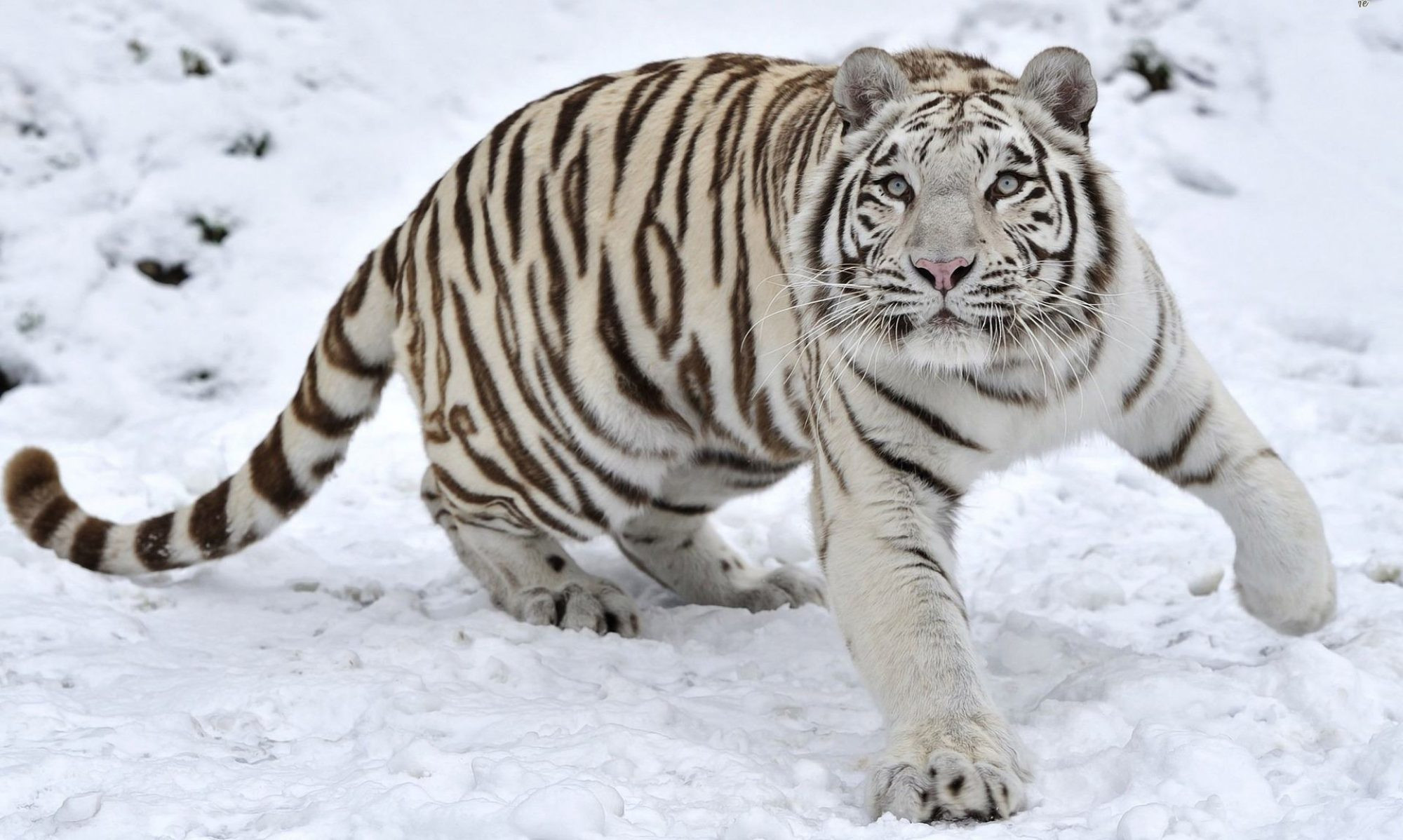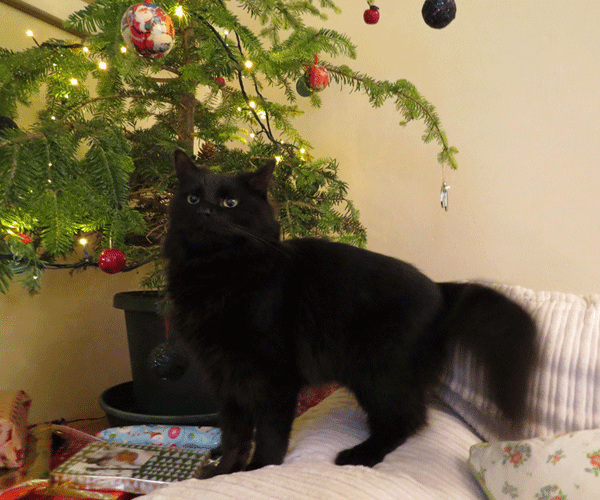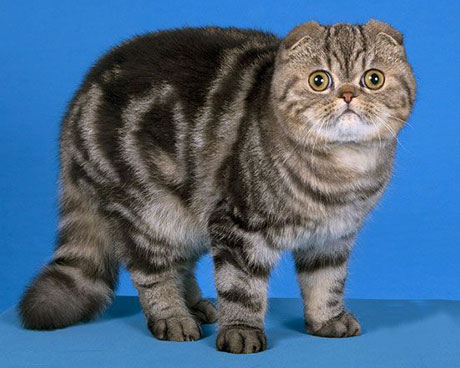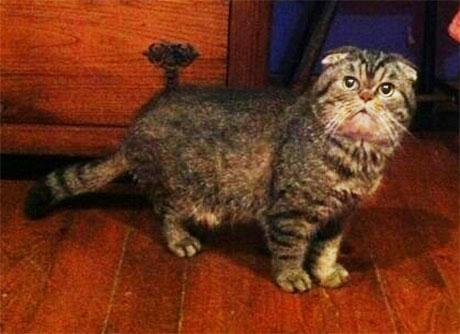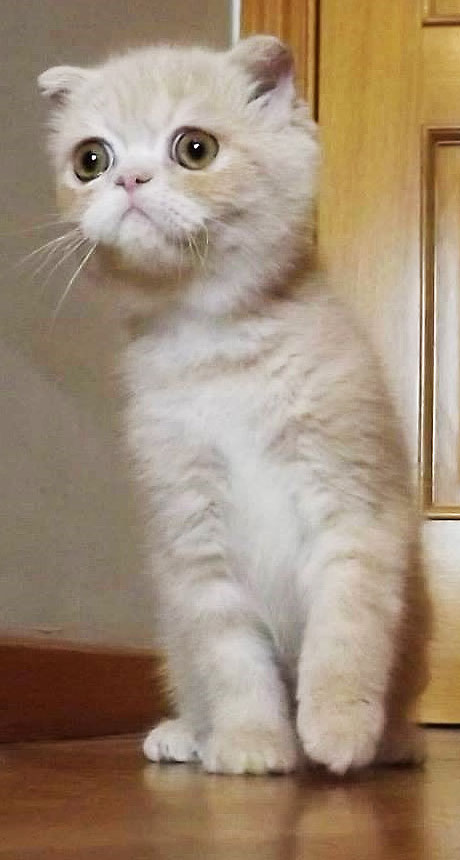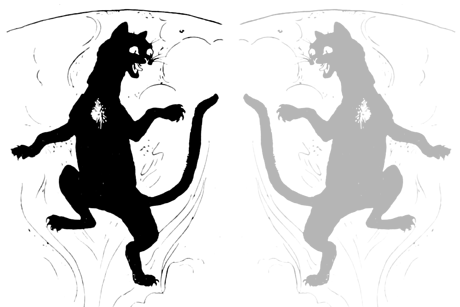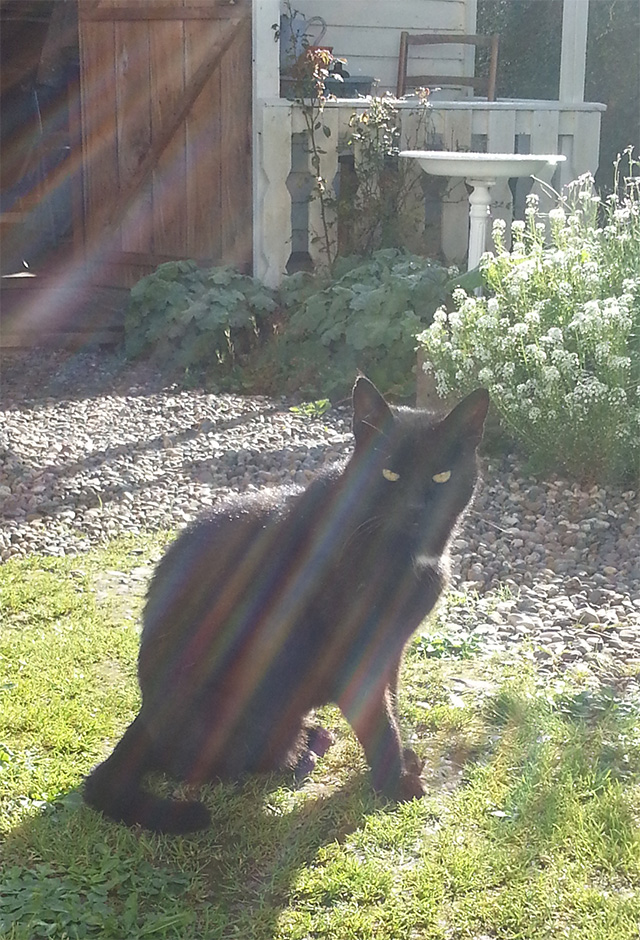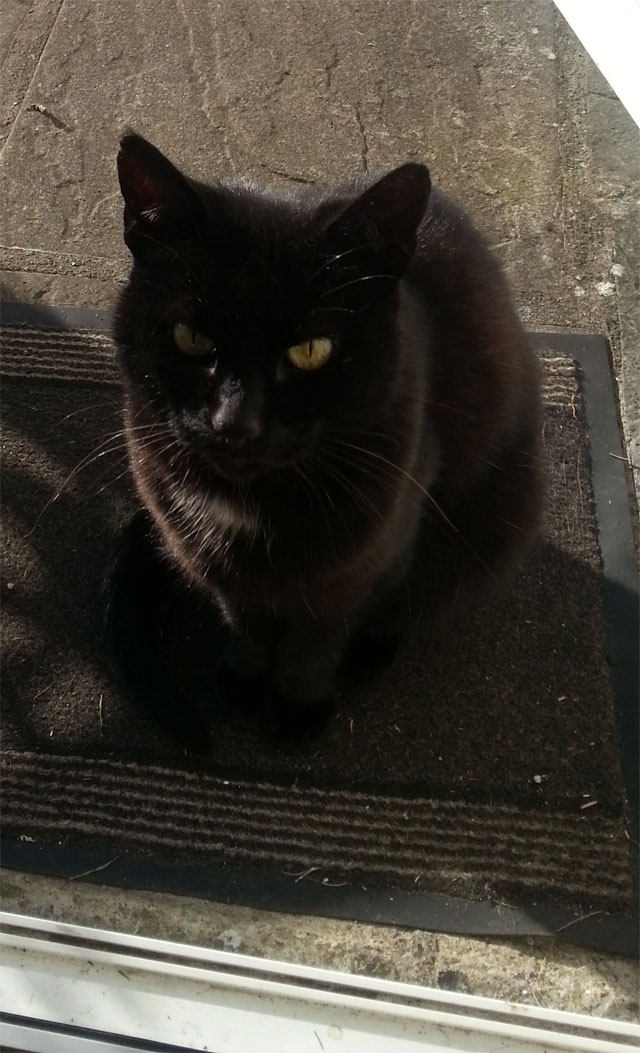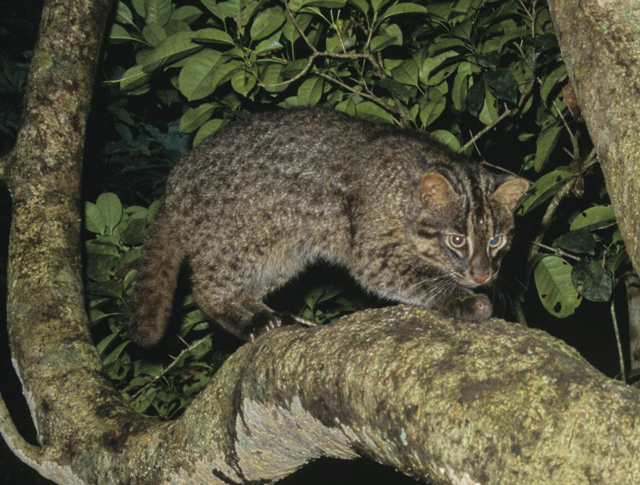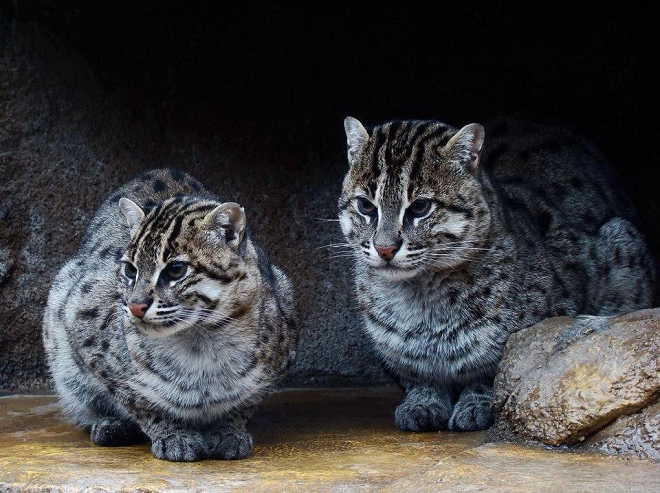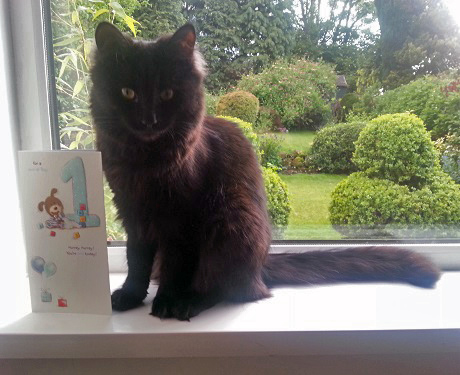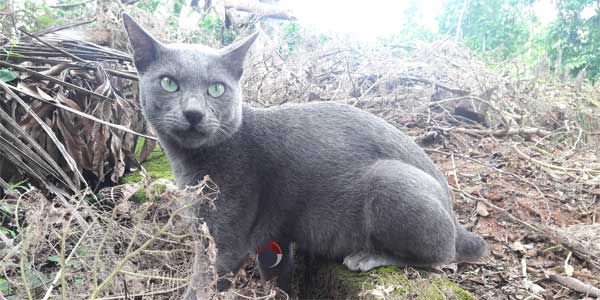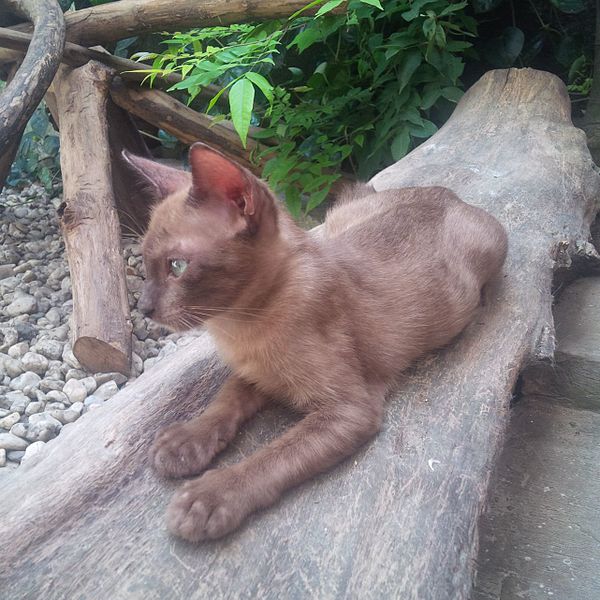Its me Oscar, who else!
Foldex
The Foldex cat breed was established by cross breeding both Exotic Shorthair and Exotic Longhair breeds with the Scottish Fold breed – it’s distinguishing feature (which characterises the Foldex breed) is a highly rounded, gathered and folded pair of ears.
Cat of the Month ~ December 2017
The Foldex breed first appeared around 1992 in Quebec, Canada as an experimental breed. This cross breeding resulted is a new Persian type breed with folded ears. This animal made its first appearance in a show hall in 1993, being presented by Betty Ann Yaxley. On viewing and admiring this new feline Jeanne Barrette dedicated herself to work with this animal well into the future. Consequently the Foldex breed was accepted as an ‘Experimental Breed’ in November of 1998 and in August of 2006 it was accepted as a New Breed for championship (cat show) status. However it is only recognised by the Canadian Cat Association (CCA).
The Foldex breed has a shorter nose than the Scottish Fold breed. Their body type is sturdy and muscular with good bone structure, a stubby neck, round eyes and a round head that give the breed a very owl like appearance. The folded ears further make the cat a little like a small ‘teddy bear’. Fully grown the weight of this cat is around five to eight pounds. Coats are dense and soft to the touch and can be long or short. The Foldex breed comes in a large variety of colours and patterns.
If allowed to breed these folded ear cats must be crossed with a straight ear cat. This must be done to avoid the potential skeletal defects associated with the breed.
Suprisingly, all Foldex breed kittens are born with straight ears. At three to four weeks the ears begin to start to bend and then fold on many of these kittens.
Many vets recommend that ears will require special cleaning care to prevent infections such as might living in the ear canal.
These felines are highly intelligent, inquisitive (of course), loving and noble cats. The make good house cats as they have a calm and docile temperament (close to that of the Exotic). While they are mostly quiet they often do like to get envolved with what’s going on in the house. The also like to play and interact with us humans when thye are in the mood.
The King O’ The Cats
The King o’ the Cats is a folk tale from the British Isles. The earliest known example is found in Beware the Cat, written by William Baldwin in 1553, though this story itself is
related to the first century story of “The Death of Pan”.
Other notable versions of this cat tale include one in a letter written by Thomas Lyttelton first published in 1782.
M. G. (Monk) Lewis the English novelist and dramatist, told the story to Percy Bysshe Shelley in 1816, and a further version was adapted by Joseph Jacobs, the Australian folklorist and writer, from several sources, including one collected by Charlotte S. Burne (the first woman president of the Folklore Society).
Walter Scott reported that ‘the King O’ The Cats’ was a well known nursery tale in the Scottish Highlands in the eighteenth century. It can be categorised as a “death of an elf (or cat)”. It is a common type of tale you can look up on the webpage Aarne-Thompson-Uther Classification of Folk Tales
“Well Osc I never knew that an “elf” was a cat! …. mind you you’re a bit of an impish elf yourself on occasion”
On to the story…I suggest you turn down the lights…and turn off all distractions … :- )
The King O’ The Cats
One winter’s evening the sexton’s wife was sitting by the fireside with her big black cat, Old Tom, on the other side, both half asleep and waiting for the master to come home.
They waited and they waited, but still he didn’t come, till at last he came rushing in, calling out, ‘Who’s Tommy Tildrum?’ in such a wild way that both his wife and his cat stared at him to know what was the matter.
‘Why, what’s the matter?’ said his wife, ‘and why do you want to know who Tommy Tildrum is?’
‘Oh, I’ve had such an adventure. I was digging away at old Mr Fordyce’s grave when I suppose I must have dropped asleep, and only woke up by hearing a cat’s Miaou.’
‘Miaou!’ said Old Tom in answer.
‘Yes, just like that! So I looked over the edge of the grave, and what do you think I saw?’
‘Now, how can I tell?’ said the sexton’s wife.
‘Why, nine black cats all like our friend Tom here, all with a white spot on their chestesses. And what do you think they were carrying? Why, a small coffin covered with a black velvet pall, and on the pall was a small coronet all of gold, and at every third step they took they cried all together, Miaou — ‘
‘Miaou!’ said Old Tom again.
‘Yes, just like that!’ said the sexton; ‘and as they came nearer and nearer to me I could see them more distinctly; because their eyes shone out with a sort of green light. Well, they all came towards me, eight of them carrying the coffin, and the biggest cat of all walking in front for all the world like — but look at our Tom, how he’s looking at me. You’d think he knew all I was saying.’
‘Go on, go on,’ said his wife; ‘never mind Old Tom.’
‘Well, as I was a-saying, they came towards me slowly and solemnly, and at every third step crying all together, Miaou –‘
‘Miaou!’ said Old Tom again.
‘Yes, just like that, till they came and stood right opposite Mr Fordyce’s grave, where I was, when they all stood still and looked straight at me. I did feel queer, that I did! But look at Old Tom; he’s looking at me just like they did.’
‘Go on, go on,’ said his wife; ‘never mind Old Tom.’
‘Where was I? Oh, they stood still looking at me, when the one that wasn’t carrying the coffin came forward and, staring straight at me, said to me — yes, I tell ‘ee, said to me, with a squeaky voice, “Tell Tom Tildrum that Tim Toidrum’s dead,” and that’s why I asked you if you knew who Tom Tildrum was, for how can I tell Tom Tildrum Tim Toldrum’s dead if I don’t know who Tom Tildrum is?’
‘Look at Old Tom, look at Old Tom!’ screamed his wife.
And well he might look, for Tom was swelling and Tom was staring, and at last Tom shrieked out, ‘What — old Tom dead! then I’m the King o’ the Cats!’ and rushed up the chimney and was nevermore seen.
trad.
Blackie
Cat of the Month ~ September 2017
Blackie is a faithful 3 year old domestic cat with great hunting ability. She lives in County Roscommon in the republic of Ireland where life is peaceful and slow for most. But if you are a bird or a mouse you’d better have your wits about you when Blackie is about!
She is often seen depositing little presents on her cottage doorstep, accompanied by great howls of “look at me” and “a’rnt I a clever puss”.
Hey Osc, you could learn a thing or two from this here puss
The Iriomote Cat
Cat of the Month ~ July 2017
The Iriomote cat is probably a subspecies of the leopard cat or may be the sole member of an entirely separate genus (Mayailurus Iriomotensis)….who knows!
Iriomote live only on the small Japanese island of Iriomote or ‘Iriomote-jima’ and nowhere else on the planet. The island lies 200 kilometers to the east of Taiwan and has a total area of 113 square miles (292 sq km).
Iriomote cats have a dark grey and brown fur colour with lighter hair on the belly and insides of the limbs. The sides are marked with rows of dark brown spots, which often form into stripes around the neck and legs. It has been observed that the Iriomote cat has a relatively elongate and low-slung build, with short legs. The tail is dark brown (with a darker spots pattern on the back sides) whilst the underside of the tail is solid dark brown as is the very tip of the tail. It has rounded ears with black fur spread along the edges. Adult Iriomote cats have a white spot on the back of each ear, much like those found on tigers’ ears. Young Iriomote cats do not have these marks, and even as adults the spots will not be as white as those seen on other leopard cat subspecies. Its eyes are a light amber shade and there are two dark brown spots on each cheek.
Habitat
Iriomote cats have been seen in wooded mountainous areas, open country and even mangrove swamps and beaches along the island shores. They will though also climb trees, wade into water and even swim. It is thought to spend most of its time alone and, like many wild cats, is mostly nocturnal and especially active during twilight hours. During the daytime, they tend to sleep in tree hollows or in caves (out of the heat of the day and no doubt away from human disturbance). To mark territory they will urinate and defecate on rocks, tree stumps and bushes. Their home ranges vary from 1 to 7 sq km (or 0.38 to 2.7 sq miles) in area.
Food
Recent studies into the cat’s diet reveal that its prey includes animals such as fruit bats, birds, wild pig, rodents, reptiles, amphibians, and crab. The cat also can swim well and will catch fish if the opportunity presents. It has been shown that these cats prefer areas near rivers, forest edges, and places with low humidity.
Iriomote cats are carnivorous and prey on various mammals, birds, reptiles, amphibians, fish, and crustaceans. They typically ingest 400–600 gramms (0.88–1.32 lb) of food a day. Other wild cats primarily hunt small mammals, such as rodents and rabbits, but because there are no other carnivores to compete with the Iriomote cat on the island, there is no need for them to isolate themselves from the various habitats and food sources that are available. Thus, their diet is quite varied.
Mammalian prey includes black rats, Ryukyu flying foxes and young Ryukyu wild boar. Their prey also includes a wide range of birds, such as the spot-billed duck, slaty-legged crake, Eurasian scops-owl, pale thrush, and white-breasted waterhen. Reptiles include various types of snakes and Kishinoue’s giant skink. They are also known to hunt Sakishima rice frogs, yellow-spotted crickets and crabs. As their hunting grounds tend to be in swamps or on shores, they sometimes swim and dive to catch water birds, fish, and freshwater prawns.
When eating birds that are larger than a dusky thrush, most types of cats will pluck the feathers and then eat it, but the Iriomote cat will eat even large birds whole without removing the feathers. “How big is a dusky thrush Ed?”….no idea Osc… let me just look that up.
Since the Iriomote cat mainly inhabits the lowland coastal regions of the island, the cat is in direct conflict with the island’s human population. Recent estimates have put the total Iriomote cat population to be as low as 100 individuals. The threats to this rare cat are loss of habitat, growing competition from the island’s feral cat population, and tourism.
Names
The Iriomote cat (Prionailurus bengalensis iriomotensis) was discovered in 1965 by Yukio Togawa (戸川幸夫 Togawa Yukio), an author who specialized in works about animals. In 1967, it was first described by Yoshinori Imaizumi, director of the zoological department of the National Museum of Nature and Science in Tokyo. However before its scientific discovery, the Iriomote cat was known locally by various beautiful names. In Japanese, the cat is called Iriomote-yamaneko (西表山猫, “Iriomote mountain cat”). In local dialects of the Yaeyama language, it is known as yamamayaa (ヤママヤー, “the cat in the mountain”), yamapikaryaa (ヤマピカリャー, “that which shines on the mountain”), and meepisukaryaa (メーピスカリャー, “that which has flashing eyes”).
This small cat has been listed as critically endangered on the IUCN Red List since 2008, as the only population comprises fewer than 250 adult individuals and is considered declining. As of 2007, there were an estimated 100–109 individuals remaining. It is certainly one of the rarest of cats, with its entire population contained on one Japanese island.
Source: From Wikipedia & others
Happy Birthday Oscar
Myths of the Raas Cat
Cat of the Month ~ May 2017
The Raas cat is a native animal on the Indonesian island of Raas in East Java. The Rass Cat is also known as a Busok or Buso Madura (or just Madura) cat. It is said that the Raas cat is from a pure breed line without mixed genes from other cat races. However this cat is not yet recognised by
Tica as a cat breed.
Raas village cats are considered very special and are highly protected by local inhabitants who, it is said, prevent export of these cats from the island shores. They are known to the islanders as either “Cat Buso” (grey cat), or “Cat Madura” (blue cat). It is believed the blue-gray or Maew Boran stock had been taken to the island on trading ships many years ago.
The Madura breed is now in decline and this has been documented in a study carried out by Lesley Morgan (ACF – Australia) and Dr. Ronny Rachman Noor (Faculty of Animal Science, Bogor Agricultural University). The study also concluded that these cats may be descended from the Korat cat breed and that they are now a closed colony of bobtailed blue cats. It appears that the declining numbers of cats of this type on both Raas and on Madura suggest a high degree of in-breeding and weakening of the breed. A further trait of these cats is that some have cinnamon coat color. These are rarer to find and known as Amethyst Raas.
The study continues: ‘…the cats posture and the triangular facial shape are similar to the ‘leopard’. The cats are large with a medium length tail with a visible bend or kink at the end. The true Madura cat (buso) is solid gray often with lavender nose leather. A few so-called Madura cats found on Madura Island have brown sepia, mink and colourpoint patterns as well as blue bi-colours. This is due to mating with local cats in the region’. The study goes on to mention the variety of cross-bred cats found on the surrounding islands, including; Korat, Burmese, Tonkinese (mink) and Siamese. Each of these had kinked tails typical of the Raas cat which further shows that cross breeding has occurred.
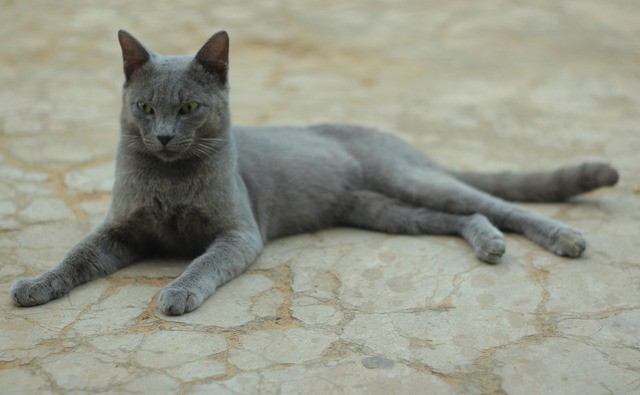
There are several myths surrounding the Raas breed. It is said that:
- the Raas cat is believed to have a sixth sense
- the true Madurese paint (i.e. cat) originating from Raas Island, may only be kept by ‘important’ people such as religious leaders and high ranking government officials.
- anyone attempting to smuggle a cat from Raas island (especially if they are an unmarried person,) will find … “their boat sinking!”
- if the said person survives the shipwreck then that person will instead be dogged with misfortune.
For more information on the Raas cat visit the official Site of the Raas Cat. Please note that a web page translation may be required.
